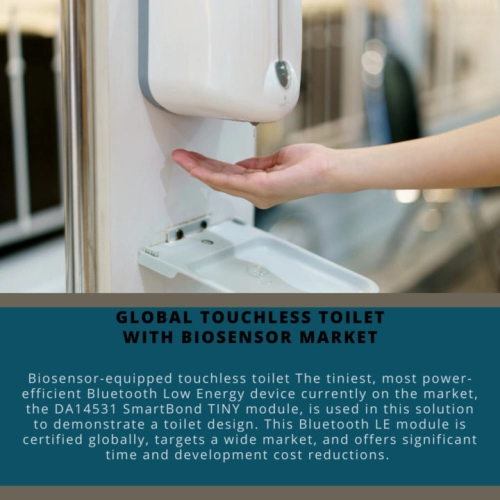
- Get in Touch with Us

Last Updated: Apr 25, 2025 | Study Period: 2022-2030
Biosensor-equipped touchless toilet The tiniest, most power-efficient Bluetooth Low Energy device currently on the market, the DA14531 SmartBond TINY module, is used in this solution to demonstrate a toilet design. This Bluetooth LE module is certified globally, targets a wide market, and offers significant time and development cost reductions.

The Bluetooth LE module has an integrated antenna and user-friendly software, which makes Bluetooth Low Energy development simpler than ever. It also has an MCU. Strong power source: AC/DC + Buck power devices with excellent performance and output capacity are sufficient to meet all power supply requirements. Design that is more intelligent keeps consumers healthier
The Global Touchless Toilet with Biosensor market accounted for $XX Billion in 2021 and is anticipated to reach $XX Billion by 2030, registering a CAGR of XX% from 2022 to 2030.
LivThing announced the launch of an innovative external home-use touchless toilet flush system.
LivFlush is high-tech but ready to use, inexpensive to install, efficient in terms of energy use, and easy to use. In just two seconds, a touchless flush may be activated thanks to its broad angle intelligent infrared sensor.
Since LivFlush has a sleek, contemporary design and a strong built-in quick-charge battery, it is more practical and ready for use than other toilet flush sensors found in conventional consumer markets. With merely a piece of tape to secure it to the toilet tank lid, it is simple to install on the tank.
Additionally, LivFlush's distinctive and incredibly adaptable touchless flush mechanism concentrates waterflow with each flush, thereby minimizing the amount of virus droplets that shoot through the air. A considerably safer and cleaner living environment is guaranteed by LivFlush. Full flush and half flush modes are available with LivFlush, which uses less water than conventional flushing systems and lowers daily water use, making it ideal for the water conservation movement.
| Sl no | Topic |
| 1 | Market Segmentation |
| 2 | Scope of the report |
| 3 | Abbreviations |
| 4 | Research Methodology |
| 5 | Executive Summary |
| 6 | Introduction |
| 7 | Insights from Industry stakeholders |
| 8 | Cost breakdown of Product by sub-components and average profit margin |
| 9 | Disruptive innovation in the Industry |
| 10 | Technology trends in the Industry |
| 11 | Consumer trends in the industry |
| 12 | Recent Production Milestones |
| 13 | Component Manufacturing in US, EU and China |
| 14 | COVID-19 impact on overall market |
| 15 | COVID-19 impact on Production of components |
| 16 | COVID-19 impact on Point of sale |
| 17 | Market Segmentation, Dynamics and Forecast by Geography, 2022-2030 |
| 18 | Market Segmentation, Dynamics and Forecast by Product Type, 2022-2030 |
| 19 | Market Segmentation, Dynamics and Forecast by Application, 2022-2030 |
| 20 | Market Segmentation, Dynamics and Forecast by End use, 2022-2030 |
| 21 | Product installation rate by OEM, 2022 |
| 22 | Incline/Decline in Average B-2-B selling price in past 5 years |
| 23 | Competition from substitute products |
| 24 | Gross margin and average profitability of suppliers |
| 25 | New product development in past 12 months |
| 26 | M&A in past 12 months |
| 27 | Growth strategy of leading players |
| 28 | Market share of vendors, 2022 |
| 29 | Company Profiles |
| 30 | Unmet needs and opportunity for new suppliers |
| 31 | Conclusion |
| 32 | Appendix |